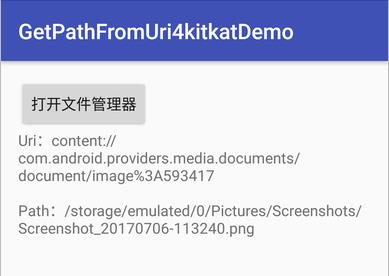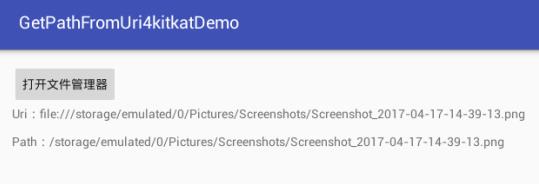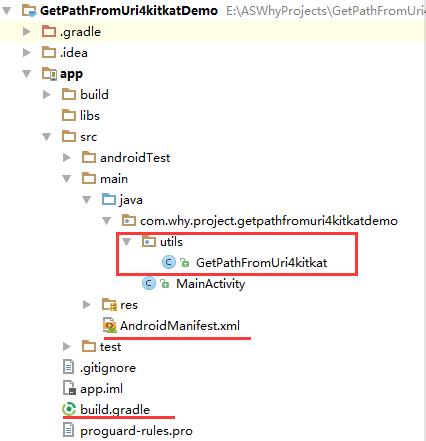java 根据文件获取文件名及路径的方法
Posted
tags:
篇首语:本文由小常识网(cha138.com)小编为大家整理,主要介绍了java 根据文件获取文件名及路径的方法相关的知识,希望对你有一定的参考价值。
我现在知道了这个文件,但是想得到这个文件在FTP上的路径及文件名称,新手,望高手详细回答!
我写了一段遍历某个文件查找指定文件的,你自己改成你需要的功能。import java.io.File;
import java.util.HashMap;
public class Test1
static HashMap<String, String> filelist=new HashMap<String, String>();
/**
* 递归方法
* @param path 文件路径
*/
public static void find(String path)
File file=new File(path);
File[] files = file.listFiles();
//如果文件数组为null则返回
if (files == null)
return;
for (int i = 0; i < files.length; i++)
if (files[i].isDirectory())
//判断是不是文件夹,如果是文件夹则继续向下查找文件
find(files[i].getAbsolutePath());
else
//记录文件路径
String filePath = files[i].getAbsolutePath().toLowerCase();
//记录文件名
String fileName=files[i].getName().toLowerCase();
// System.out.println("---"+strFileName);
filelist.put(fileName, filePath);
public static void main(String[] args)
//需要遍历的路径,也就是你要查找文件所在的路径
String path="D:\\kpi\\";
find(path);
System.out.println("kpi.9的路径:"+filelist.get("kpi.9"));
//输出结果:d:\kpi\kpi.9
追问
留下你QQ,以后有问题多交流
追答804396258,给个最佳答案吧
参考技术A 通过File类获取文件,然后通过以下两种方法获取绝对路径和名称。返回类型为String获取绝对路径:file.getAbsolutePath()
获取名称: file.getName() 参考技术B 获取路径:file.getAbsolutePath()
获取名称: file.getName()追问
能详细点吗?我是新手、怎么把这个文件赋值给file呢
追答可以new一个File File file = new File(地址)
如果是流的话 通过流获得文件
我现在就是要得到这个地址啊,怎么会在new file的时候有他呢!new File(这里我不知道地址,是想得到地址的)
追答那你有没有文件名及文件类型呢?那只能通过遍历根节点来找到它了
追问没有,问题很简单,有了BLOB文件,想得到文件的路径,就这么简单!
参考技术C FTP追问FTP 然后呢
参考技术D 从root开始,逐个目录搜索追问不要说思路,我知道思路,是不会写,我是新手嗯!
追答ftp server上的, 还得看你用哪个ftp的lib,所以代码还是你自己写吧。
反过来说,你确定使用哪个ftp lib之后,你会很快写出来了。
说了等于白说,你被淘汰了!
追答无语。
GetPathFromUri4kitkatAndroid 4.4 kitkat以上及以下根据uri获取路径的方法
版权声明:本文为HaiyuKing原创文章,转载请注明出处!
前言
在Android4.4之前和之后,通过Intent调用文件管理器选择文件,获取的文件uri地址形式是不同的。
Android6.0 content://com.android.providers.media.documents/document/image%3A593410
Android4.2.2 file:///storage/emulated/0/Pictures/Screenshots/Screenshot_2017-04-17-14-39-13.png
所以,当我们需要用到文件的绝对路径地址(/storage/emulated/0/Pictures/Screenshots/Screenshot_20170706-113240.png)的时候,则需要一个通用的方法。
效果图
| Android 6.0 | Android4.2.2 |

|

|
代码分析
一般使用getPath( context,uri)方法即可。
使用步骤
一、项目组织结构图

注意事项:
1、导入类文件后需要change包名以及重新import R文件路径
2、Values目录下的文件(strings.xml、dimens.xml、colors.xml等),如果项目中存在,则复制里面的内容,不要整个覆盖
二、导入步骤
将GetPathFromUri4kitkat.java文件复制到项目中

package com.why.project.getpathfromuri4kitkatdemo.utils; import android.annotation.SuppressLint; import android.content.ContentUris; import android.content.Context; import android.database.Cursor; import android.net.Uri; import android.os.Build; import android.os.Environment; import android.provider.DocumentsContract; import android.provider.MediaStore; import java.io.File; /** * @CreateBy HaiyuKing * @Used Android 4.4 kitkat以上及以下根据uri获取路径的方法 * @参考资料 http://www.2cto.com/kf/201502/376975.html */ public class GetPathFromUri4kitkat { /** * 专为Android4.4设计的从Uri获取文件绝对路径,以前的方法已不好使 * @param uri - Android6.0 content://com.android.providers.media.documents/document/image%3A593410 * Android4.2.2 file:///storage/emulated/0/Pictures/Screenshots/Screenshot_2017-04-17-14-39-13.png * @return Android6.0 /storage/emulated/0/Pictures/Screenshots/Screenshot_20170706-113240.png * Android4.2.2 /storage/emulated/0/Pictures/Screenshots/Screenshot_2017-04-17-14-39-13.png */ @SuppressLint("NewApi") public static String getPath(final Context context, final Uri uri) { final boolean isKitKat = Build.VERSION.SDK_INT >= Build.VERSION_CODES.KITKAT; // DocumentProvider if (isKitKat && DocumentsContract.isDocumentUri(context, uri)) { // ExternalStorageProvider if (isExternalStorageDocument(uri)) { final String docId = DocumentsContract.getDocumentId(uri); final String[] split = docId.split(":"); final String type = split[0]; if ("primary".equalsIgnoreCase(type)) { return Environment.getExternalStorageDirectory() + "/" + split[1]; } // TODO handle non-primary volumes } // DownloadsProvider else if (isDownloadsDocument(uri)) { final String id = DocumentsContract.getDocumentId(uri); final Uri contentUri = ContentUris.withAppendedId( Uri.parse("content://downloads/public_downloads"), Long.valueOf(id)); return getDataColumn(context, contentUri, null, null); } // MediaProvider else if (isMediaDocument(uri)) { final String docId = DocumentsContract.getDocumentId(uri); final String[] split = docId.split(":"); final String type = split[0]; Uri contentUri = null; if ("image".equals(type)) { contentUri = MediaStore.Images.Media.EXTERNAL_CONTENT_URI; } else if ("video".equals(type)) { contentUri = MediaStore.Video.Media.EXTERNAL_CONTENT_URI; } else if ("audio".equals(type)) { contentUri = MediaStore.Audio.Media.EXTERNAL_CONTENT_URI; } final String selection = "_id=?"; final String[] selectionArgs = new String[] { split[1] }; return getDataColumn(context, contentUri, selection, selectionArgs); } } // MediaStore (and general) else if ("content".equalsIgnoreCase(uri.getScheme())) { return getDataColumn(context, uri, null, null); } // File else if ("file".equalsIgnoreCase(uri.getScheme())) { return uri.getPath(); } return null; } /** * Get the value of the data column for this Uri. This is useful for * MediaStore Uris, and other file-based ContentProviders. * * @param context * The context. * @param uri * The Uri to query. * @param selection * (Optional) Filter used in the query. 构造筛选语句 * @param selectionArgs * (Optional) Selection arguments used in the query. * @return The value of the _data column, which is typically a file path. */ public static String getDataColumn(Context context, Uri uri, String selection, String[] selectionArgs) { Cursor cursor = null; //筛选列 final String column = MediaStore.Files.FileColumns.DATA;//"_data" final String[] projection = { column }; try { cursor = context.getContentResolver().query(uri, projection, selection, selectionArgs, null); if (cursor != null && cursor.moveToFirst()) { final int column_index = cursor.getColumnIndexOrThrow(column); return cursor.getString(column_index); } }catch (IllegalArgumentException e){ //java.lang.IllegalArgumentException: column \'_data\' does not exist //华为的特殊处理:content://com.huawei.hidisk.fileprovider/root/storage/emulated/0/tencent/TIMfile_recv/xxx.doc String rootPre = File.separator + "root";// /root return uri.getPath().startsWith(rootPre) ? uri.getPath().replace(rootPre,"") : uri.getPath(); } finally { if (cursor != null) cursor.close(); } return null; } /** * @param uri * The Uri to check. * @return Whether the Uri authority is ExternalStorageProvider. */ public static boolean isExternalStorageDocument(Uri uri) { return "com.android.externalstorage.documents".equals(uri.getAuthority()); } /** * @param uri * The Uri to check. * @return Whether the Uri authority is DownloadsProvider. */ public static boolean isDownloadsDocument(Uri uri) { return "com.android.providers.downloads.documents".equals(uri.getAuthority()); } /** * @param uri * The Uri to check. * @return Whether the Uri authority is MediaProvider. */ public static boolean isMediaDocument(Uri uri) { return "com.android.providers.media.documents".equals(uri.getAuthority()); } }
在AndroidManifest.xml中添加权限
<?xml version="1.0" encoding="utf-8"?> <manifest xmlns:android="http://schemas.android.com/apk/res/android" package="com.why.project.getpathfromuri4kitkatdemo"> <!-- ======================(GetPathFromUri4kitkat)========================== --> <!-- 向SD卡读取数据权限 --> <uses-permission android:name="android.permission.READ_EXTERNAL_STORAGE"/> <application android:allowBackup="true" android:icon="@mipmap/ic_launcher" android:label="@string/app_name" android:supportsRtl="true" android:theme="@style/AppTheme"> <activity android:name=".MainActivity"> <intent-filter> <action android:name="android.intent.action.MAIN"/> <category android:name="android.intent.category.LAUNCHER"/> </intent-filter> </activity> </application> </manifest>
添加运行时权限的处理(本demo中采用的是修改targetSDKVersion=22)
三、使用方法
package com.why.project.getpathfromuri4kitkatdemo; import android.app.Activity; import android.content.Intent; import android.net.Uri; import android.os.Bundle; import android.support.v7.app.AppCompatActivity; import android.util.Log; import android.view.View; import android.widget.Button; import android.widget.TextView; import com.why.project.getpathfromuri4kitkatdemo.utils.GetPathFromUri4kitkat; public class MainActivity extends AppCompatActivity { private static final String TAG = "MainActivity"; private Button btn_openFile; private TextView tv_filePath; @Override protected void onCreate(Bundle savedInstanceState) { super.onCreate(savedInstanceState); setContentView(R.layout.activity_main); initViews(); initEvents(); } private void initViews() { btn_openFile = (Button) findViewById(R.id.btn_openFile); tv_filePath = (TextView) findViewById(R.id.tv_filePath); } private void initEvents() { btn_openFile.setOnClickListener(new View.OnClickListener() { @Override public void onClick(View v) { Intent innerIntent = new Intent(Intent.ACTION_GET_CONTENT); String IMAGE_UNSPECIFIED = "*/*"; innerIntent.setType(IMAGE_UNSPECIFIED); // 查看类型 Intent wrapperIntent = Intent.createChooser(innerIntent, "File Browser"); MainActivity.this.startActivityForResult(wrapperIntent, 1111); } }); } /*=========================================实现打开文件管理器功能==============================================*/ @Override public void onActivityResult(int requestCode, int resultCode, Intent data) { super.onActivityResult(requestCode, resultCode, data); Log.w(TAG, "{onActivityResult}resultCode=" + resultCode); Log.w(TAG, "{onActivityResult}requestCode=" + requestCode); if (resultCode == Activity.RESULT_OK) { //调用文件管理器选择文件的回调 if (requestCode == 1111) { Uri result = data == null ? null : data.getData(); Log.w(TAG, "{onActivityResult}result=" + result); tv_filePath.setText("Uri:"+result.toString()); String pathStr = GetPathFromUri4kitkat.getPath(MainActivity.this,result); Log.w(TAG, "{onActivityResult}pathStr=" + pathStr); tv_filePath.setText(tv_filePath.getText() + "\\n\\n" + "Path:"+pathStr); } } } }
混淆配置
无
参考资料
Android 4.4 kitkat以上及以下根据uri获取路径的方法
项目demo下载地址
以上是关于java 根据文件获取文件名及路径的方法的主要内容,如果未能解决你的问题,请参考以下文章
